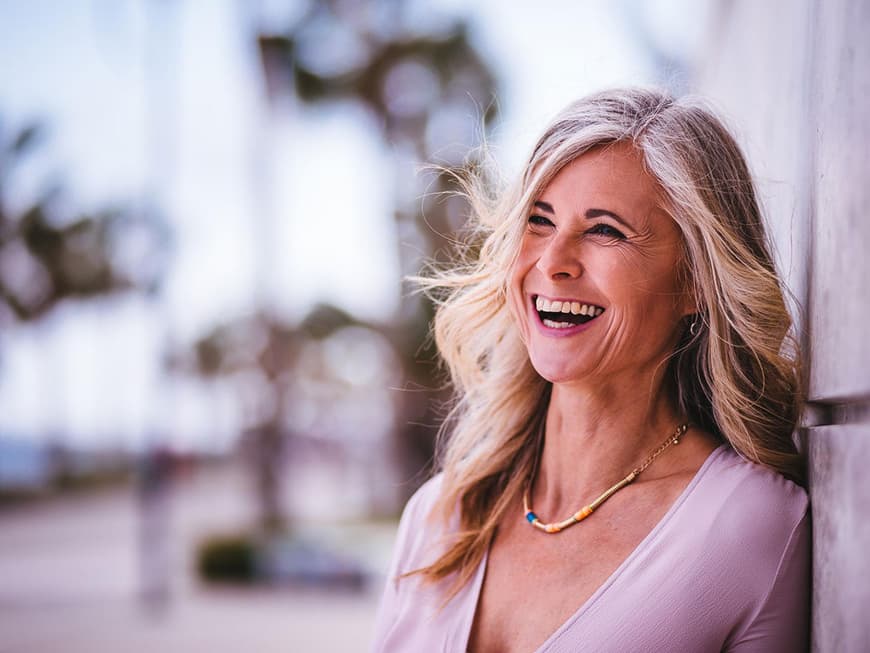
Mechanical stress
What exactly is it?
"It is caused by washing and combing the hair. Of course this is necessary, but it is also a daily recurring strain."
How does this damage the hair?
"Cleaning substances and friction can roughen the surface of the fibers. This makes it more susceptible to breakage."
What can you do about it?
"The best way to combat mechanical stress is to regularly pamper your hair with the right system care, consisting of shampoo and conditioner. This ensures that the hair is healthy enough to withstand daily stress. The conditioner plays a particularly important role in this. It closes the hair structure, wraps itself around the hair like a protective film, makes it easier to comb and makes it smoother overall. It is best to use hairbrushes with natural bristles. They resemble the structure of human hair and are therefore particularly gentle and kind to the hair. If you still use plastic brushes
, make sure that they do not have sharp edges, as these tear the hair."
Thermal stress
What exactly is it?
"It is caused by exposure to heat, for example when blow-drying or using curling irons and straighteners."
How does this damage the hair?
"Styling with heat makes the hair more susceptible to split ends and broken lengths. Hairdryers and the like can also put a lot of strain on the structure of the hair and the scalp."
What can you do about it?
"My tip for all women: Only use straighteners or curling irons when your hair is 100 percent dry. Otherwise it will be burnt, causing small bubbles on the surface of the hair, which can lead to hair damage. I always recommend applying heat protection to the hair before using a hairdryer, curling iron or straightener. It is also a good idea to give your hair a little break every now and then and simply let it air dry instead of blow-drying it. But even here, sufficient care is necessary to protect the hair. I recommend regularly using a dry oil with vitamin E, for example from Pantene Pro-V. Its vitamin E provides noticeable smoothness - the hair is easier to comb and easier to style. It also helps to prevent hair damage."
Chemical stress
What exactly is it?
"It is mainly caused by treatments such as perms and coloring. This includes complete hair coloring as well as coloring individual strands (high and lowlights)."
How does this damage the hair?
"Chemical treatment with color attacks the hair and puts a lot of strain on it. This can cause the surface of the hair to become porous, making it more susceptible to all external influences. The result is often hair damage, which leads to split ends and broken ends."
What can you do about it?
"Care is very important. It is essential to use products specially formulated for color-treated hair. Special shampoos restore the hair's protective layer and lock in the color, while conditioners help to protect against styling damage. Together they ensure beautiful shine and more luminosity. And: gentler coloring alternatives are tints or plant-based colorants."
Environmental stress
What exactly is this?
"It is also known as oxidative stress. It is triggered by external influences such as UV radiation from the sun, but also by pollution in the air such as carbon dioxide, i.e. CO2."
How does this damage the hair?
"One consequence is that the hair becomes lighter as the sun breaks down the pigments. This can then lead to the breakdown of the protein structure and has an effect on the lipids. These are the hair's natural oils. Oxidative stress causes the hair to lose lipids. The result is hair that is straw-like, brittle and no longer flexible. UV light also attacks the core of each hair and makes it more susceptible to split ends."
What can you do about it?
"Here too, care is the be-all and end-all. To protect the hair from environmental stress, it needs to be strengthened, i.e. the lipid structure needs to be rebuilt. The '3 Minute Miracle Conditioner' from Pantene Pro-V, for example, is enriched with antioxidants and replenishing lipids."
